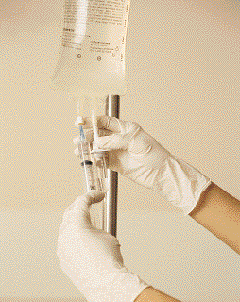Ativan Drips and Precipitation
/ If you happen to run short of the lorazepam 2 mg/mL vials to compound your ativan drips, be mindful of the possibility of precipitation when using the lorazepam 4 mg/mL vials. AHFS Drug Info states:
If you happen to run short of the lorazepam 2 mg/mL vials to compound your ativan drips, be mindful of the possibility of precipitation when using the lorazepam 4 mg/mL vials. AHFS Drug Info states:
Precipitation-- The choice of commercial lorazepam concentration to use in the preparation of dilutions is a critical factor in the physical stability of the dilutions. Both the 2- and 4-mg/mL concentrations utilize the same concentrations of solubilizing solvents. On admixture, the solvents that keep the aqueous insoluble lorazepam in solution are diluted twice as much using the 4-mg/mL concentration than if the 2- mg/mL were used, resulting in different precipitation potentials for the same concentration of lorazepam. Care should be taken to ensure that the compounding procedure that is to be used for lorazepam admixtures has been demonstrated to result in solutions in which the lorazepam remains soluble.Lorazepam concentrations up to 0.08 mg/mL have been reported to be physically stable, while occasional precipitate formation in admixtures of lorazepam 0.1 to 0.2 mg/mL has been reported. The precipitate has been observed in both containers and in administration set tubing.
In one case, a visible precipitate formed in a lorazepam 0.5-mg/mL admixture in sodium chloride 0.9% in a glass bottle. However, a 0.5-mg/mL concentration may remain in solution longer if prepared from the 2-mg/mL concentration, yielding a higher concentration of organic solvents in the final admixture.
Concentrations of 1 and 2 mg/mL have been reported to be physically stable for up to 24 hours as well as concentrations below 0.08 mg/mL.
Concentrations in the middle range of 0.8 to 1 mg/mL may be problematic. In one report, use of lorazepam 2 mg/mL to prepare lorazepam 1-mg/mL admixtures in dextrose 5% or sodium chloride 0.9% was acceptable but use of the lorazepam 4-mg/mL concentration to prepare the same solutions resulted in almost immediate precipitation.
Lorazepam solubility in common infusion solutions has been reported. Its solubility in sodium chloride 0.9% is approximately half that found in the other tested solutions. This result was attributed to the pH of the sodium chloride 0.9% (pH 6.3) being essentially the same as the isoelectric point of lorazepam (pH 6.4), where aqueous solubility would be the lowest. Dextrose 5% was the best diluent for lorazepam.
If you are a hospital or facility that mixes the middle range of 0.8mg to 1 mg/mL you have to be more mindful of other factors. This is the reason I had no idea of this problem since other facilities where I have worked we mixed a much less concentrated solution. I found out the validity of this information and wasn't too pleased.
The bottom line is that it would be nearly impossible for a pharmacist to know every single intricacies of different hospitals and compounding practices. If knowledge like this is indeed something we should all 100% know, then someone somewhere dropped the ball on training and/or education. I am mostly wondering, how does your facility compound ativan drips? What scenarios caused precipitation?
For more about this issue read here.

